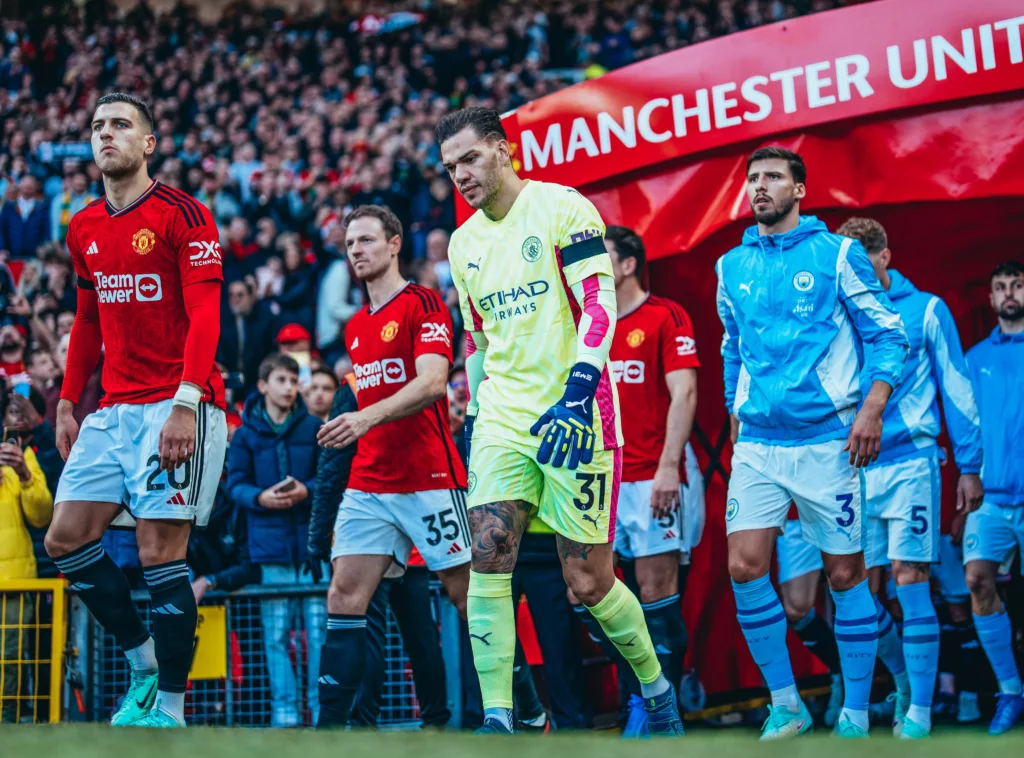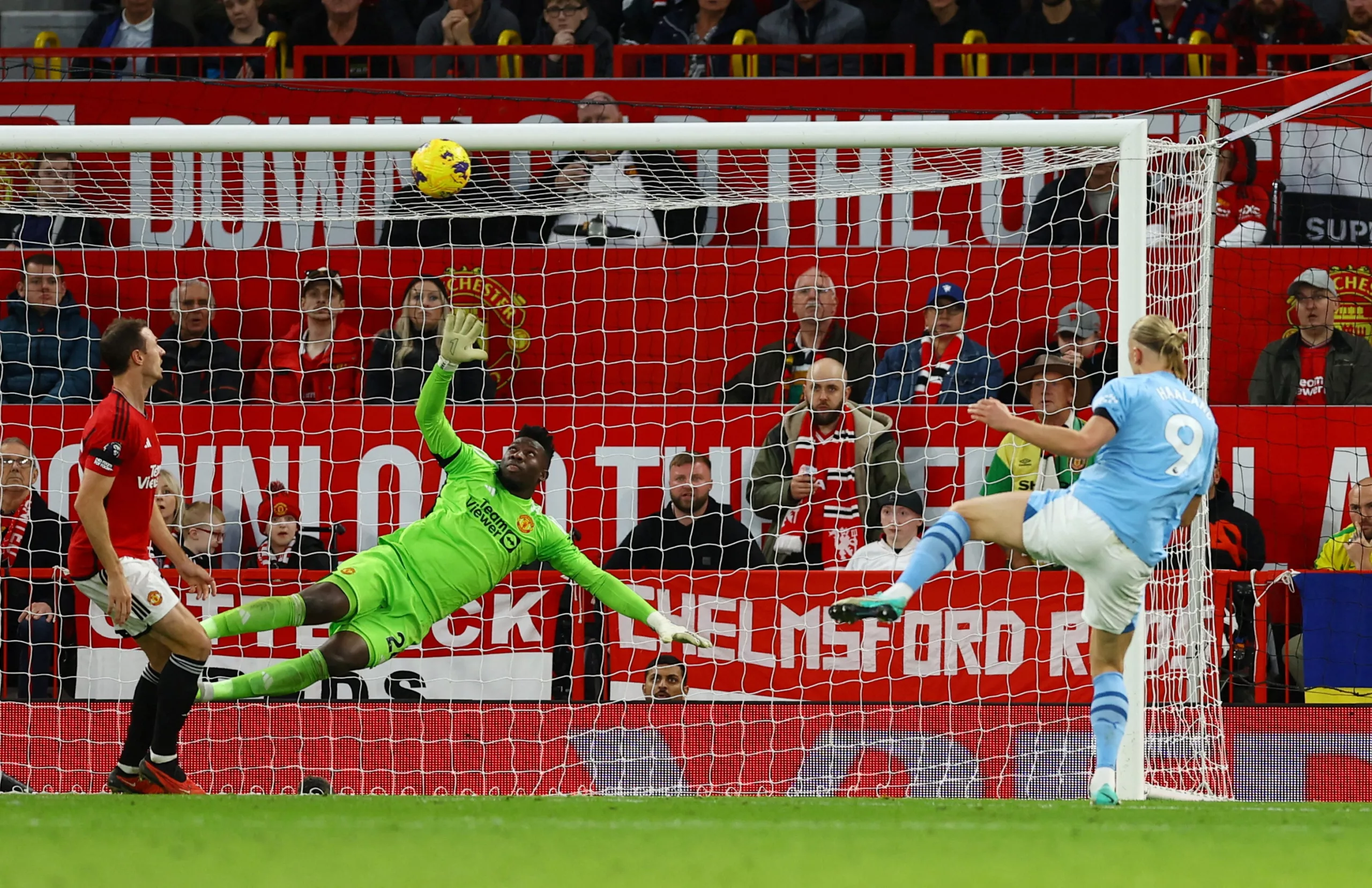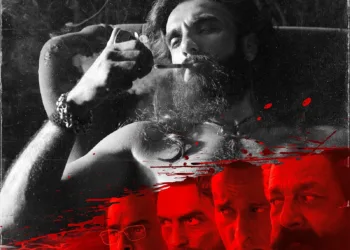In-Depth Analysis of the Manchester Derby: Tactical Insights and Key Moments
In this extensive analysis of the thrilling Manchester derby, we explore the intricate strategies employed by both Manchester United and Manchester City. By scrutinizing their tactical approaches and dissecting significant moments from the match, we uncover the nuanced details that unfolded during this high-stakes encounter.

Read More: Premier League 2023-24 | Manchester United vs Manchester City : Preview & Predictions
Manchester United’s Tactical Approach: Building from the Back
Strategic Central Overloads
From the very outset of the match, Manchester United displayed their intent to construct their play from the back. They tactically orchestrated central overloads to counteract Manchester City’s hybrid pressing system. One notable instance saw Rodri being drawn out of position by Amrabat, thereby providing McTominay with the opportunity to exploit the created space and advance the ball.
High-Press Triumph
Manchester United’s aggressive high press in the early stages of the game bore fruit when Bruno Fernandes adeptly pressed Gvardiol. This was accomplished despite Manchester City’s deliberate efforts to stretch United’s press. This high-pressing strategy set the tone for the entire match and laid the foundation for their tactical approach.
The Fullback Challenge: Support for the Press
One conspicuous tactical challenge faced by Manchester United was the lack of support from their fullbacks during the high press. Consequently, their wingers were burdened with additional defensive responsibilities, making their offensive contributions more demanding.

Navigating City’s Press: Central Overloads and Direct Play
The ability of Manchester United to bypass Manchester City’s press proved pivotal in their tactical approach. This was made possible by the strategic creation of central overloads, combined with a versatile approach that included both patient build-up play and direct, incisive moves.
City’s Resilient Press and Swift Recovery
Manchester City exhibited remarkable resilience in swiftly recovering from Manchester United’s attacks. They thwarted any attempts to exploit space. United endeavored to bait Manchester City’s press, facilitating Onana’s ability to launch long balls with ease.
Second Ball Strategy
Due to the effectiveness of Manchester City’s press, Manchester United had to rely on the second ball and loose ball situations as a means of making tactical progress. A notable example was an opportunity following Foden’s error, though it regrettably could not be converted into a goal.

City’s Building from the Back and Errors
Manchester City’s tactical blueprint in the first half involved stretching Manchester United’s press using the dynamic duo of Walker and Gvardiol, complemented by the support of Rodri and Stones. However, this period was not without its share of errors.
City’s Left-Side Overloads: Tactical Precision
Manchester City’s strategic intent was evident in their consistent pursuit of creating overloads on the left side of the pitch. This was effectively achieved through the synergy between Rodri and Walker. Quick switches of play and well-timed arrivals of attacking players disrupted Manchester United’s defensive block.

Pressing Dynamics: Bruno Fernandes vs. Rashford
A distinct difference in pressing effectiveness became apparent in the match. Bruno Fernandes proved to be a more proficient presser in comparison to Rashford. This disparity made it considerably easier for Manchester City to advance their play through the right flank.
Grealish and Bernardo’s Combinations: Creating Headaches
Manchester City’s persistent efforts revolved around the creation of combinations between Grealish and Bernardo. This tactical approach posed substantial challenges for Manchester United’s defense throughout the match.

Rotations and Defensive Challenges
Manchester United encountered difficulties in managing defensive rotations and switches. Notably, this led to situations where players like Stones found themselves unmarked and available.
Onana’s Heroic Saves
One of the standout features of the match was the exceptional performance of Onana, who made critical saves that proved pivotal for Manchester United’s tactical setup.
Grealish’s Options on the Left: Tactical Versatility
Jack Grealish consistently faced a choice when receiving the ball on the left flank. He could either opt for combinations with his teammates, notably Bernardo, or exploit the movements and runs to create space for potential shooting opportunities or crosses.
The Opening Goal and Struggles Against a Deep Block
Manchester City managed to secure the first goal through a well-taken penalty by Haaland. Manchester United encountered challenges in creating goal-scoring opportunities against Manchester City’s deep defensive block.
.@ErlingHaaland grabs the opener by sending Onana the wrong way! 🎯 pic.twitter.com/UGdTCTFsQ0
— Manchester City (@ManCity) October 29, 2023
Ten Hag’s Tactical Adjustments
Erik ten Hag made a significant tactical change in the second half by introducing Mount in place of Amrabat, resulting in an altered defensive dynamic for Manchester United. This adjustment made them more ‘open’ defensively, providing Manchester City with greater ease in breaking through.
Manchester City’s Brilliant Team Goal: Deconstructing the Beauty
A mesmerizing example of tactical brilliance was on display when Manchester City crafted their second goal. It involved building from the right side, isolating Grealish, and executing precise combinations that left Manchester United’s defense in disarray.
Doubling our lead from an @ErlingHaaland header! 🙌 pic.twitter.com/J6XnpMOA7n
— Manchester City (@ManCity) October 29, 2023
Ederson’s Passing Influence: Tactical Insights
Ederson’s passing data revealed interesting tactical nuances in Manchester City’s gameplay. The preference for playing through the right side in deeper areas allowed them to maximize overloads and combinations on the left, notably between Grealish and Bernardo.

Missed Opportunities and Defensive Adjustments by Manchester United
Manchester United capitalized on Manchester City’s high defensive line to create dangerous chances. However, Rashford couldn’t find the target. Subsequent defensive adjustments by ten Hag inadvertently opened up central areas, which Manchester City exploited to score their third goal.
This comprehensive tactical analysis encompasses the key moments and strategic intricacies that unfolded during this enthralling Manchester derby, offering an in-depth glimpse into the world of football tactics.







